名词所有格与名词性物主代词
- 格式:ppt
- 大小:1.08 MB
- 文档页数:32
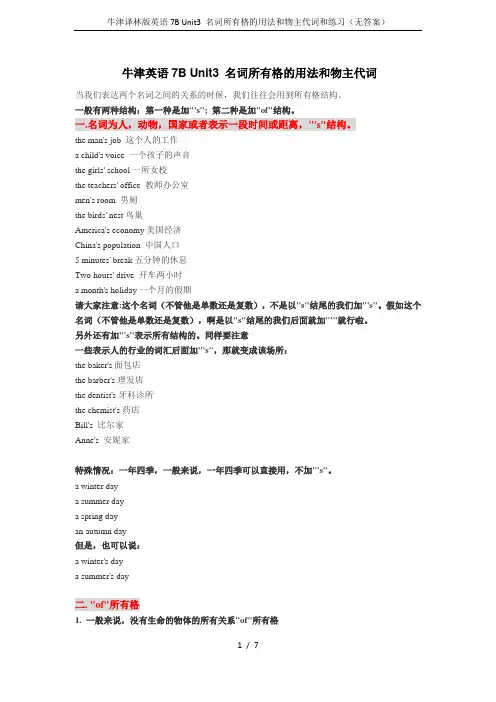
牛津英语7B Unit3 名词所有格的用法和物主代词当我们表达两个名词之间的关系的时候,我们往往会用到所有格结构。
一般有两种结构:第一种是加"'s"; 第二种是加"of"结构。
一.名词为人,动物,国家或者表示一段时间或距离,"'s"结构。
the man's job 这个人的工作a child's voice 一个孩子的声音the girls' school一所女校the teachers' office 教师办公室men's room 男厕the birds' nest鸟巢America's economy美国经济China's population 中国人口5 minutes' break五分钟的休息Two hours' drive 开车两小时a month's holiday一个月的假期请大家注意:这个名词(不管他是单数还是复数),不是以"s"结尾的我们加"'s"。
假如这个名词(不管他是单数还是复数),啊是以"s"结尾的我们后面就加"'"就行啦。
另外还有加"'s"表示所有结构的。
同样要注意一些表示人的行业的词汇后面加"'s",那就变成该场所:the baker's面包店the barber's理发店the dentist's牙科诊所the chemist's药店Bill's 比尔家Anne's 安妮家特殊情况:一年四季,一般来说,一年四季可以直接用,不加"'s"。
a winter daya summer daya spring dayan autumn day但是,也可以说:a winter's daya summer's day二. "of"所有格1. 一般来说,没有生命的物体的所有关系"of"所有格the title of the song 这首歌的歌名students of the school 这所学校的学生the top of the hill 山顶the beauty of the lake 这湖的美2.一般来说,有生命的我们也可以加"of",尤其是,假如这个名子还有别的修饰成分的时候我们肯定要加"of"。
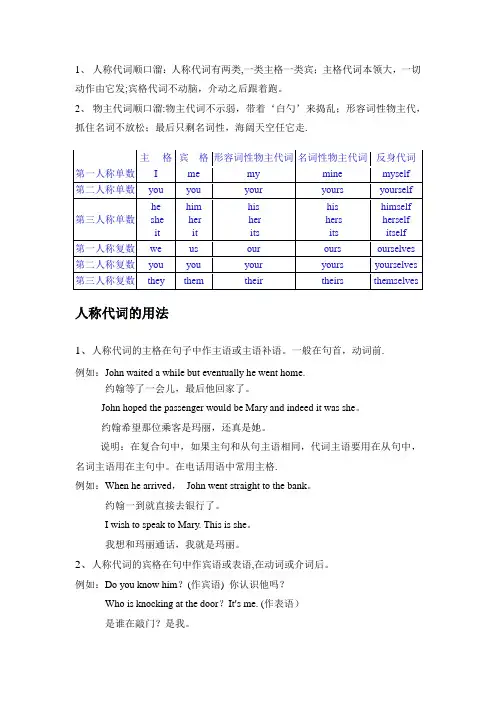
1、人称代词顺口溜:人称代词有两类,一类主格一类宾;主格代词本领大,一切动作由它发;宾格代词不动脑,介动之后跟着跑。
2、物主代词顺口溜:物主代词不示弱,带着‘白勺’来捣乱;形容词性物主代,抓住名词不放松;最后只剩名词性,海阔天空任它走.人称代词的用法1、人称代词的主格在句子中作主语或主语补语。
一般在句首,动词前.例如:John waited a while but eventually he went home.约翰等了一会儿,最后他回家了。
John hoped the passenger would be Mary and indeed it was she。
约翰希望那位乘客是玛丽,还真是她。
说明:在复合句中,如果主句和从句主语相同,代词主语要用在从句中,名词主语用在主句中。
在电话用语中常用主格.例如:When he arrived,John went straight to the bank。
约翰一到就直接去银行了。
I wish to speak to Mary. This is she。
我想和玛丽通话,我就是玛丽。
2、人称代词的宾格在句中作宾语或表语,在动词或介词后。
例如:Do you know him?(作宾语) 你认识他吗?Who is knocking at the door?It’s me. (作表语)是谁在敲门?是我。
说明:单独使用的人称代词通常用宾格,即使它代表主语时也是如此。
例如:I like English。
Me too。
我喜欢英语.我也喜欢。
3、注意:在动词be 或to be 后的人称代词视其前面的名词或代词而定。
例如:I thought it was she.我以为是她。
(主格—---主格)I thought it to be her。
(宾格---—宾格)I was taken to be she。
我被当成了她.(主格————主格)They took me to be her.他们把我当成了她.(宾格———-宾格)4、人称代词并列时的排列顺序1)单数人称代词并列作主语时,其顺序为:第二人称→第三人称→第一人称即you and I he/she/it and I you, he/she/it and I顺口溜:第一人称最谦虚,但若错误责任担,第一人称学当先.例如:It was I and John that made her angry。

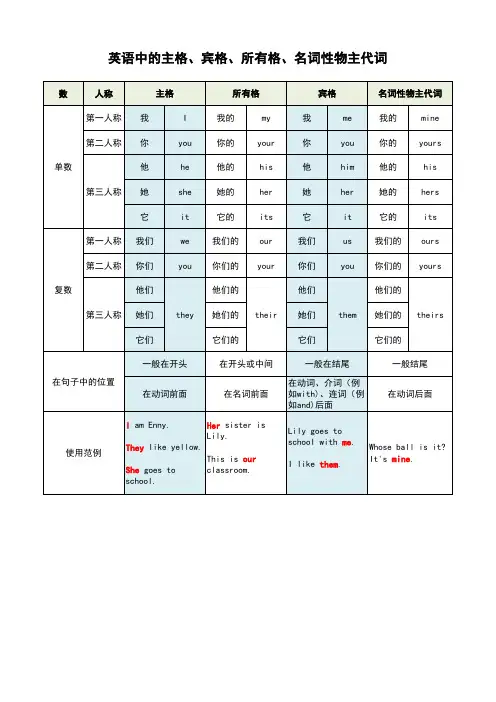
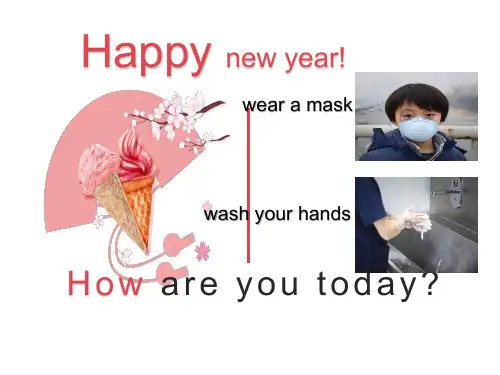
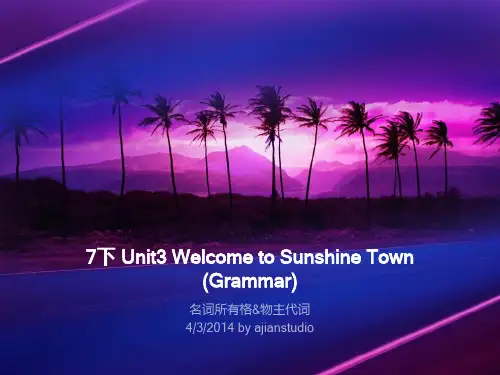
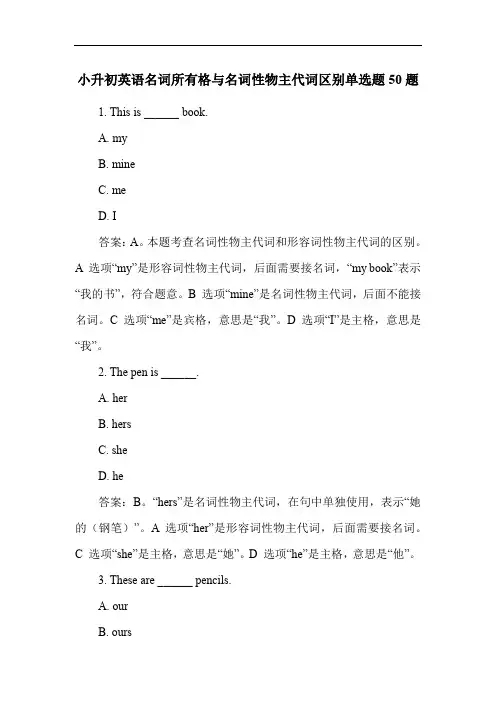
小升初英语名词所有格与名词性物主代词区别单选题50题1. This is ______ book.A. myB. mineC. meD. I答案:A。
本题考查名词性物主代词和形容词性物主代词的区别。
A 选项“my”是形容词性物主代词,后面需要接名词,“my book”表示“我的书”,符合题意。
B 选项“mine”是名词性物主代词,后面不能接名词。
C 选项“me”是宾格,意思是“我”。
D 选项“I”是主格,意思是“我”。
2. The pen is ______.A. herB. hersC. sheD. he答案:B。
“hers”是名词性物主代词,在句中单独使用,表示“她的(钢笔)”。
A 选项“her”是形容词性物主代词,后面需要接名词。
C 选项“she”是主格,意思是“她”。
D 选项“he”是主格,意思是“他”。
3. These are ______ pencils.A. ourB. oursC. weD. us答案:A。
“our”是形容词性物主代词,后接名词“pencils”,表示“我们的铅笔”。
B 选项“ours”是名词性物主代词,不能接名词。
C 选项“we”是主格。
D 选项“us”是宾格。
4. That bag is not ______.A. myB. mineC. meD. I答案:B。
“mine”在这里表示“我的((包)”,是名词性物主代词,可单独使用。
A 选项“my”后需接名词。
C 选项“me”是宾格。
D 选项“I”是主格。
5. ______ classroom is big.A. OurB. OursC. WeD. Us答案:A。
“Our”是形容词性物主代词,修饰名词“classroom”,表示“我们的教室”。
B 选项“Ours”是名词性物主代词,不能修饰名词。
C 选项“We”是主格。
D 选项“Us”是宾格。
6. This is not my room. It's ________.A. my parents'B. my parent'sC. my parentsD. parents'答案:A。
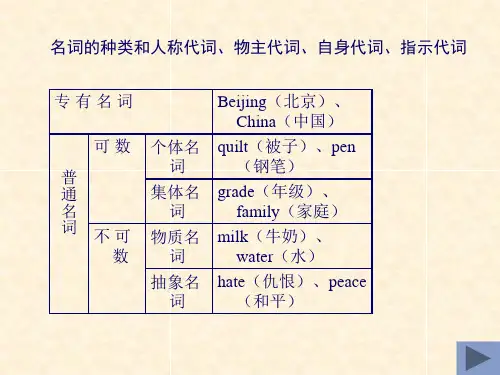
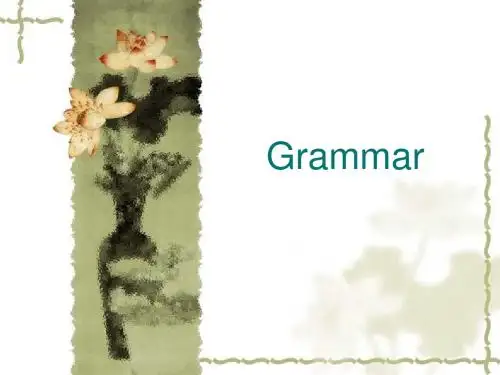
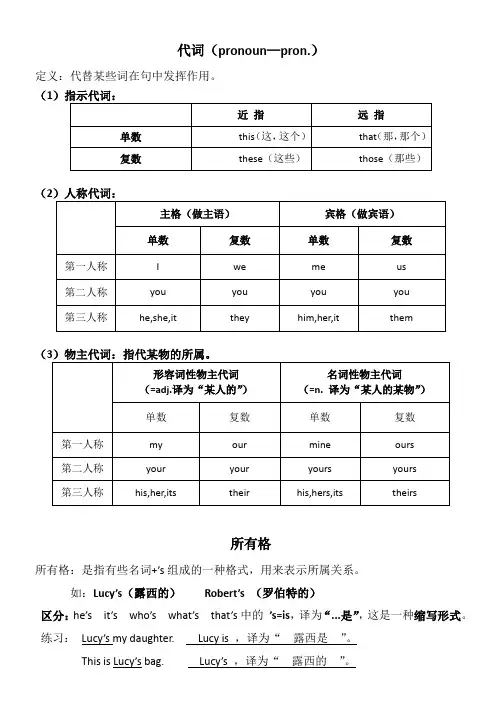
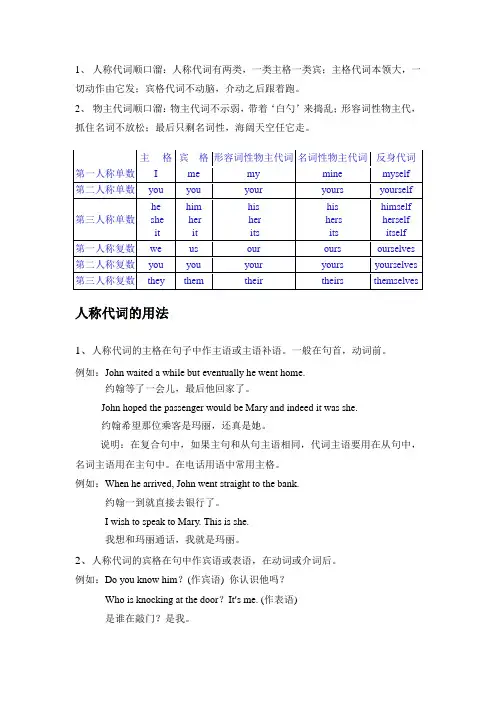
1、人称代词顺口溜:人称代词有两类,一类主格一类宾;主格代词本领大,一切动作由它发;宾格代词不动脑,介动之后跟着跑。
2、物主代词顺口溜:物主代词不示弱,带着‘白勺’来捣乱;形容词性物主代,抓住名词不放松;最后只剩名词性,海阔天空任它走。
人称代词的用法1、人称代词的主格在句子中作主语或主语补语。
一般在句首,动词前。
例如:John waited a while but eventually he went home.约翰等了一会儿,最后他回家了。
John hoped the passenger would be Mary and indeed it was she.约翰希望那位乘客是玛丽,还真是她。
说明:在复合句中,如果主句和从句主语相同,代词主语要用在从句中,名词主语用在主句中。
在电话用语中常用主格。
例如:When he arrived, John went straight to the bank.约翰一到就直接去银行了。
I wish to speak to Mary. This is she.我想和玛丽通话,我就是玛丽。
2、人称代词的宾格在句中作宾语或表语,在动词或介词后。
例如:Do you know him?(作宾语) 你认识他吗?Who is knocking at the door?It’s me. (作表语)是谁在敲门?是我。
说明:单独使用的人称代词通常用宾格,即使它代表主语时也是如此。
例如:I like English. Me too.我喜欢英语。
我也喜欢。
3、注意:在动词be 或to be 后的人称代词视其前面的名词或代词而定。
例如:I thought it was she.我以为是她。
(主格----主格)I thought it to be her.(宾格----宾格)I was taken to be she.我被当成了她。
(主格----主格)They took me to be her.他们把我当成了她。
英语人称代词、物主代词、名词所有格第一第一第二第二第三第三人称人称人称人称第三人称单数人称人称单数复数单数复数复数单数人称代词我我们你你们他她它他/她/它们汤姆主格I we you you he she it they Tom人称代词我我们你你们他她它他/她/它们汤姆宾格me us you you him her it them Tom形容词性物主我的我们的你的你们的他的她的它的他/她/它们的汤姆的代词my our your your his her its their Tom’s名词性物主代词我的(东西)我们的(东西)你的(东西)你们的(东西)他的(东西)她的(东西)它的(东西)他/她/它们的(东西)汤姆的(东西)mine ours yours yours his hers its theirs Tom’s一、人称代词分为第一人称、第二人称、第三人称;有主格和宾格两种形式。
1.人称代词主格:作主语,表示谁怎么样了、干什么了。
例:(1)I am a teacher. (2)You are a student.(3)He is a student, too. (4)We/You/They are students.2.人称代词宾格:作宾语,表示动作行为的对象。
一般放在动词和介词之后。
例:(1)Give it to me. (2)Let’s go (let’s =let us)二、物主代词可分为形容词性物主代词和名词性物主代词。
1、形容词性物主代词:起形容词的作用,用在名词前,用作定语,限定该名词的意义。
例:(1)This is my book. 这是我的书。
(2)We love our motherland. 我们热爱我们的祖国。
2. 名词性物主代词起名词的作用,后面无名词。
例:(1)Look at the two pencils. The red one is yours and the blue one is mine.看那两支铅笔,红的是你的,蓝的是我的。
第三章人称代词、物主代词、反身代词及名词所有格(一)人称代词人称代词分为主格和宾格。
人称代词的主格在句子中作主语。
如: He is a student.I don’t know.She likes reading.人称代词的宾格在句子中作宾语(动词和介词的宾语)。
如:We all like him.Look at me.(二)物主代词物主代词分形容词性物主代词和名词性物主代词两种。
形容词性物主代词后面要跟名词。
之所以叫它们“形容词”是因为它们必须放在名词前面。
“物主”则表示它们是物的主人。
如:This is my book.We love our motherland.名性词的物主代词后面不能跟名词,因为它们本身是名词性,所以后面不能再跟名词,否则就犯了重复的错误。
如:This book is mine.=This is my book.I can’t find out my pen,can I use yours?(三)反身代词反身代词有myself, yourself, himself, herself, itself, ourselves, yourselves, themselves. 分别表示我自己、你自己、他自己、她自己、它自己、我们自己、你们自己、他(她、它)们自己,单词后面的self意思是自己,selves是self的复数(变f为v再加es)。
反过来表示自己,所以叫反身代词。
如:He sees himself in the mirror.(四)名词所有格名词所有格表示所属关系,就是“……的”的表达方式。
如:玛丽的儿子Mary’s son.学校的大门the gate of the school名词所有格可分为三种:1、有生命名词所有格2、无生命名词的所有格①无生命名词所有格一般用“of+名词”的结构表示。
如:the gate of the school 学校的大门the door of the classroom 教室的门②有些表示时间、距离以及国家等无生命的名词,可以在词尾加’s或’如:a、表时间:today’s newspaper (今天的报纸)b、表距离:ten miles’ distance (十英里的距离)c、表国家、城市等实体:China’s future (中国的未来)3、双重所有格双重所有格由“of+名词所有格”如:a friend of my father’s 我爸爸的一个朋友或“of+名词性物主代词”如:a friend of mine 我的一个朋友(五)用下列词的适当形式填空1. Who is ______( they ) teacher?2. ______( he ) name is Tom .3.This is _____ (I) pen.4. Look at _____( I).5. What’s ______ (you ) name?6. The teacher ask ____ ( you ) to read the book.7. Who is _____ ( he)?8. I like ____ ( he ).9. This is ____( he ) mother.10. The beautiful girl is ______( she ) sister.11. _____ (they ) are my classroom.12. Look at _____ ( they ) . _____ ( they ) are so strong .13. The football is _____ ( they ).14. The pretty woman is _____ ( we) teacher.15. _____ ( we) are good friends.16. Let _____ (we) sing a song together.17. ____ (I) have two big eyes .18. What color are _____( you ) eyes ?19. _____ (I)eyes are blue.20. _____ ( they ) teacher is Tom .(六)选择1> This is _________A: Jack’s T-shirt B: Jack’T-shirt C: T-shirt of Jack2>That is __________A: Doris’ book B: book of Doris C: book to Doris3>These are __________A: drivers’s cars B: drivers’ cars C: cars to drivers4> Those are ________A: mothers’ bags B: mothers’s bags C: bags of mothers5> This is _______A: question ’s answer B: the answer to the question C: the answer of question6>This is _________A: classroom’s door B: door to classroom C: the door of the classroom7> These are ______A: the bag of the bosses B: bosses’s bags C: bosses’ bags8> This is ______A: the key of the door B: the door’s key C: the key to the door9> ______ is on the desk.A: Kim’s pen .B: Kim’s pen C: the pen of Kim10>_____ is over there .A: My mother’es dress B: My mother’s dress C:The dress of my mother课后练习一、用所给单词适当形式填空1. ________ am a student . _______name is Peter. The book is _______.(I)2. ______ are in China. These are not _______coats. ______ are over there.(their)3. ________ (who) pen is this. I think it’s ________(Bill)4. The book is _________(Mary and Jane)5. The pens are the _________(students)二. 用人称代词填空:1. Tell ___(我们)how to get there.2. Put ___(它们)there.3. ___(他们)say ___(她)is very clever.4. Who is there? It’s ___(我).5. What time is ___? ___’s 12o’clock.6. How far is ___ to the zoo?7. ___ is so cold today.8. Tell ___(我)how far is ___ from Shanghai to Nanking.9. ___’s damp and cold. ___ think ___’s going to rain.10. Show ___ how to do ___.三. 用物主代词填空:1. Is this ___(你的)classroom? No, it’s not ___(我们的). It’s ___(他们的).2. ___(他的)father is a teacher and ___(她的)is an engineer.3. ___(谁的)keys are these? —They are ___(他的), not ___(我的).4. This isn’t ___(我的)car; ___(我的)is being repaired.5. Is the coat ___(你的)or ___(她的)? It’s ___(我的),not ___(她的).6. ___(她的)views of life and very different from ___(我们的).7. This is ___(我的)umbrella and that one is ___(你的).8. This coat of ___(你的)is much nicer than ___(我的).9. Those ties of ___(他们的)must be more expensive than ___(我们的).10. I like ___(你的)better than ___(她的).四. 用反身代词填空:1. The old man lives by ______.2. I am sure I can do it all by _______.3. Mary is old enough to take care of ______.4. Can you carry this box upstairs by _______.5. We can finish this task by _______.。